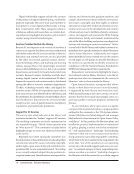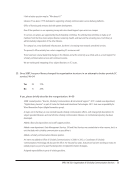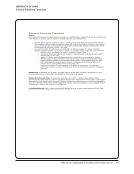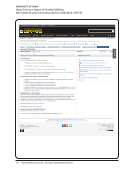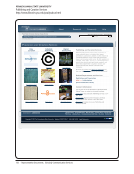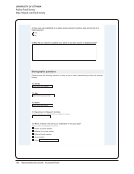SPEC Kit 332: Organization of Scholarly Communication Services · 55
SC services have shifted between library divisions (technical services, public services, library information technology) and
now report the to AUL for Scholarly Communication, Assessment, and Personnel.
Scholarly Communication &Access Division -Collection Development Department and Information Delivery Department
are now in the same division as the Scholarly Communication &Digital Curation Department and the Collection
Acquisitions &Management Department.
Technical services librarian and support staff hiring, particularly metadata support data curation staff support
digitization librarian hired digital preservation librarian hired GIS librarian hired digital initiatives staff configured into
library organization work team digital initiatives committee formed born digital materials working group formed.
The library structure has not been reorganized, but new positions relating to SC services have been created since 2007,
e.g., digital scholarly publishing officer, scholarly communications librarian.
The open access/scholarly communication services were handled by the associate university librarian, technology and
scholarly communication. In a major reorganization, the office of scholarly communication was set up as described
above.
The role that collections management played in gifts and assessment of collection support for new programs has been
downplayed, to free up time for greater emphasis on SC. Collections management was subsumed into a larger unit
of collections &external relations that also includes our archives &special collections department. It is understood
that digitization and digital publishing will go hand in hand and thus these two former units are working more closely
together and sharing expertise.
The SC department was formed in mid-2011. The department grew to include an e-science librarian in early 2012 (up
until then it included the IP and digital publishing librarians). A ½-time staff person was added in early 2012 to work on
operations.
The scholarly communication librarian was a member of a department in the public services division. When the position
was vacated, it was rewritten and a center to support SC activities was established, with a reporting line directly to the
dean of libraries.
The scholarly communications committee was established in 2007. Open access funding support began in 2009.
The Libraries has moved from traditional library divisions (i.e., public services and technical services) to a libraries
management team comprised of eight department heads, reporting to two associate deans (senior associate dean,
associate dean) and the dean of libraries. Reporting to the senior associate dean are the following re-organized
departments: libraries information technology, circulation, scholarly resource development (collection development,
acquisition, ILL borrowing), library administration &budget. Reporting to the associate dean: archives &special
collections, arts &humanities, metadata services, sciences, social sciences. The members of the newly formed scholarly
communications working group represent individuals from seven of the eight departments. The Libraries re-organization
is intended to reduce traditional boundaries and divisions and encourage team collaboration across units.
We expanded an existing department, then called Digital Collection Services, to include an additional 3 FTE librarians to
support SC efforts. The department changed its name to Scholarly Communication and Licensing to better reflect these
responsibilities and its relationship to the AUL who oversees these activities.
We had a team that was just on the main campus with a regional member. The major schools (main, health, law) are
drawing closer together in a variety of ways now, so this team composition is indicative of a larger trend.
We have added staff supporting digital humanities and eScience and organized the support for digital projects by faculty
and students in a single working group called the Center for Digital Scholarship (CDS).
SC services have shifted between library divisions (technical services, public services, library information technology) and
now report the to AUL for Scholarly Communication, Assessment, and Personnel.
Scholarly Communication &Access Division -Collection Development Department and Information Delivery Department
are now in the same division as the Scholarly Communication &Digital Curation Department and the Collection
Acquisitions &Management Department.
Technical services librarian and support staff hiring, particularly metadata support data curation staff support
digitization librarian hired digital preservation librarian hired GIS librarian hired digital initiatives staff configured into
library organization work team digital initiatives committee formed born digital materials working group formed.
The library structure has not been reorganized, but new positions relating to SC services have been created since 2007,
e.g., digital scholarly publishing officer, scholarly communications librarian.
The open access/scholarly communication services were handled by the associate university librarian, technology and
scholarly communication. In a major reorganization, the office of scholarly communication was set up as described
above.
The role that collections management played in gifts and assessment of collection support for new programs has been
downplayed, to free up time for greater emphasis on SC. Collections management was subsumed into a larger unit
of collections &external relations that also includes our archives &special collections department. It is understood
that digitization and digital publishing will go hand in hand and thus these two former units are working more closely
together and sharing expertise.
The SC department was formed in mid-2011. The department grew to include an e-science librarian in early 2012 (up
until then it included the IP and digital publishing librarians). A ½-time staff person was added in early 2012 to work on
operations.
The scholarly communication librarian was a member of a department in the public services division. When the position
was vacated, it was rewritten and a center to support SC activities was established, with a reporting line directly to the
dean of libraries.
The scholarly communications committee was established in 2007. Open access funding support began in 2009.
The Libraries has moved from traditional library divisions (i.e., public services and technical services) to a libraries
management team comprised of eight department heads, reporting to two associate deans (senior associate dean,
associate dean) and the dean of libraries. Reporting to the senior associate dean are the following re-organized
departments: libraries information technology, circulation, scholarly resource development (collection development,
acquisition, ILL borrowing), library administration &budget. Reporting to the associate dean: archives &special
collections, arts &humanities, metadata services, sciences, social sciences. The members of the newly formed scholarly
communications working group represent individuals from seven of the eight departments. The Libraries re-organization
is intended to reduce traditional boundaries and divisions and encourage team collaboration across units.
We expanded an existing department, then called Digital Collection Services, to include an additional 3 FTE librarians to
support SC efforts. The department changed its name to Scholarly Communication and Licensing to better reflect these
responsibilities and its relationship to the AUL who oversees these activities.
We had a team that was just on the main campus with a regional member. The major schools (main, health, law) are
drawing closer together in a variety of ways now, so this team composition is indicative of a larger trend.
We have added staff supporting digital humanities and eScience and organized the support for digital projects by faculty
and students in a single working group called the Center for Digital Scholarship (CDS).














